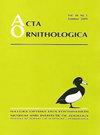Insulation of Common Chaffinch Fringilla coelebs Nests is Largely Driven by Animal-Derived Materials in the Cup Lining
IF 1.3
4区 生物学
Q3 ORNITHOLOGY
引用次数: 6
Abstract
Abstract. Incubation of eggs and nestlings is energetically costly and may be affected by the amount of thermal insulation the surrounding nest provides. In many small passerine species, animal-derived materials, i.e., feathers and hair, are often used in the nest lining where, presumably, their lower thermal conductance offers better insulation. A previous study that involved partial deconstruction of thrush nests revealed that different parts of the nest confer different levels of insulation. The present study examined the insulatory values of Common Chaffinch Fringilla coelebs nests because of the high proportion of animal-derived materials in their cup lining but not the outer nest. Insulatory values and cooling rates of temperature loggers inside the cup were determined for whole nests and then only the cup lining. There were no significant relationships between nest measurements and measures of thermal insulation. However, removal of the outer nest wall reduced the insulatory value by around 10% despite the cup lining being less than half the thickness of the complete nest wall and the cup lining being only a third of the total nest mass. Differential placement of animal-derived materials within the cup lining of Common Chaffinch nests means that the birds seem to be able to confer a high level of insulation without expending too much energy searching for a large mass of particular nest materials.普通鳕鱼巢的隔热主要是由杯内衬中的动物来源材料驱动的
摘要孵化蛋和雏鸟在能量上是昂贵的,并且可能受到周围巢穴提供的隔热量的影响。在许多小型雀形目物种中,动物来源的材料,即羽毛和毛发,通常用于巢衬,据推测,它们较低的热导率提供了更好的隔热效果。之前的一项研究对画眉鸟巢穴进行了部分解构,结果表明,巢穴的不同部分具有不同的隔热水平。本研究考察了普通Chaffinch Fringilla coelebs巢穴的隔热价值,因为它们的杯状内衬中动物来源的材料比例很高,但外部巢穴中没有。确定了整个巢和仅杯衬的杯内温度记录器的绝缘值和冷却率。巢穴测量和隔热措施之间没有显著的关系。然而,尽管杯形衬里小于整个巢壁厚度的一半,并且杯形衬里仅为总巢质量的三分之一,移除外部巢壁将绝缘值降低了约10%。将动物来源的材料不同地放置在普通Chaffinch巢穴的杯状内衬中,这意味着鸟类似乎能够提供高水平的绝缘,而不会花费太多精力寻找大量特定的巢穴材料。
本文章由计算机程序翻译,如有差异,请以英文原文为准。
求助全文
约1分钟内获得全文
求助全文
来源期刊

Acta Ornithologica
生物-鸟类学
CiteScore
2.10
自引率
0.00%
发文量
14
审稿时长
>12 weeks
期刊介绍:
Publishes scientific papers (original research reports, reviews, short notes, etc.) and announcements from all fields of ornithology. All manuscripts are peer-reviewed.
Established in 1933 as Acta Ornithologica Musei Zoologici Polonici, since 1953 continued under the present title.
Published twice a year by the Natura Optima Dux Foundation under the auspices of the Museum and Institute of Zoology, Polish Academy of Sciences.
 求助内容:
求助内容: 应助结果提醒方式:
应助结果提醒方式:


